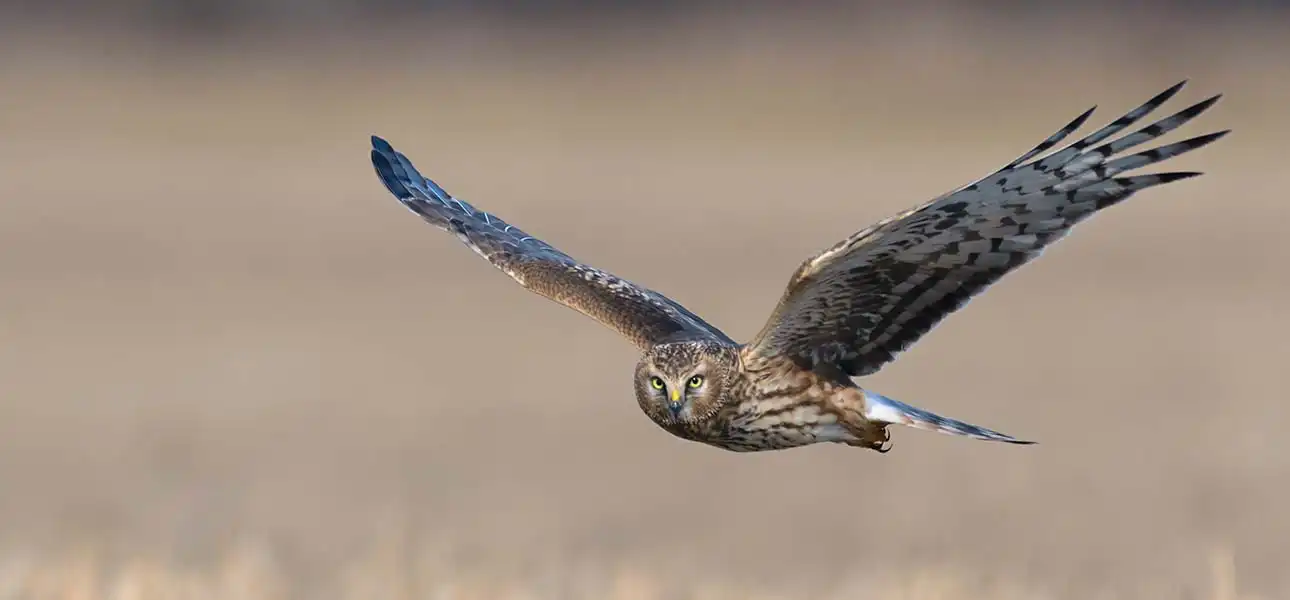
Hen Harriers are one of the birds that is distinctive of upland habitats but, sadly, it is also one of our most threatened. They have suffered for many years, persecuted for the belief they took farmyard fowl, and driven from suitable habitats by forestry and the planting of huge areas of trees. They also prey on Red Grouse chicks, one of the naturally occurring birds in the upland heather moorlands where Hen Harriers breed, along with Meadow Pipit and waders. Unfortunately Red Grouse are both economically valuable due to the revenue they bring through game shooting and also bred in huge numbers meaning they are far more common on those moorlands than they would naturally be – just too much of a temptation for the harriers, who are seen as a threat to the industry and subsequently suffer persecution.
Key facts
Common name: Hen Harrier
Scientific name: Circus cyaneus
Habitat: Upland heather moors, mostly in Scotland, in winter they are found more widely across the country and may be found anywhere there are open habitats, although they favour rough grasslands and heaths.
Diet: Small birds and mammals but will take insects, reptiles and amphibians when available
Size: Average 48cm, wingspan 110cm. Females (500g) larger than males (350g)
Status: Resident breeding bird. Migrant. Passage and winter visitor
Population size: 545 pairs
Conservation status: RED (due to long-term population and range decline)
Appearance
Male Hen Harriers are distinctive birds, plain silver grey above, with long narrow wings and black tips and a dark trailing edge. They have a white rump and a long grey tail. They are mostly white below and typically hold their long wings in a ‘V’-shape. The females and juveniles are less obvious – being brown and heavily streaked, but they share the white rump (and are often referred to as ‘Ringtails’). All Hen Harriers show five ‘fingers’ at the wing tip, and this separates them from the rarer harriers that may also occur. All harriers have owl-like facial masks, and this bears testament to the fact that a lot of their hunting is done through sound.
Lifespan
The average lifespan is 7 years, with an adult survival rate of 81% year on year. First year survival is not known, but birds have a 22% chance of reaching their second year, when they will begin breeding. The oldest known wild bird in the world was 15 years and 9 months old (ringing recovery).
Nesting
Hen Harriers nest on the ground, either deep in the low vegetation or on a slight incline. The nest is relatively simple, just a scrape with some sticks, grass, and leaves. Hen Harriers practice polygyny – where one male will mate with and provision the nests of more than one female. Research has shown that this is more likely when food availability is high.
Number of eggs: 4-5
Incubation: 34 days
Fledging time: 37-42 days
Habitat and Distribution
During the breeding season Hen Harriers are very much birds of upland heather moors, mostly in Scotland. Elsewhere in their large world range, across Europe and Asia they have a wider habitat tolerance when breeding, and can be found in grassland, agricultural crops and even marshes. A tiny population occurs in northern England, with others in North Wales and in Ireland. In certain areas, they are more commonly encountered, such as on Orkney and Isle of Man. In winter they are found more widely across the country and can, potentially, be found anywhere there are open habitats, although they favour rough grasslands and heaths.
Movements
Hen Harriers range widely in their first couple of years before settling to breed and may travel far from their natal sites. In winter British birds may move to lower altitudes and may head south into England or even further afield, although ringing has shown that many of the birds that occur in southern England in winter have originated from northern and central Europe. Other populations of Hen Harriers are strongly migratory.
Feeding
Hen Harriers, as with all the harrier species, hunt low over the ground, slowly quartering an area looking and listening for prey. They principally take small birds and small mammals, but they are adaptable and will take insects, reptiles and amphibians when available. They often target nestlings, and will tackle larger prey, which they have been observed drowning to subdue. Hen Harriers have also been seen hunting bats. Nestlings of passerines and waders are targeted, but the high density of gamebirds in the habitats that Hen Harriers breed in means that grouse chicks are targeted, usually when the harriers have extra demands due to feeding their young.

